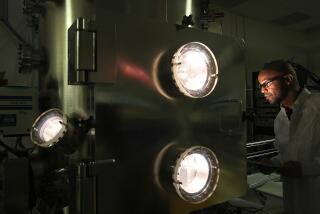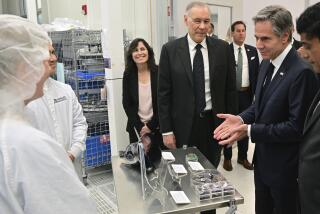Xerox to Spin Off Research Center
- Share via
Troubled Xerox Corp. said Tuesday that it will turn its famed Palo Alto Research Center into an independent company Jan. 1 in an effort to keep the lab afloat while the copier maker focuses on its core growth areas. But analysts are pessimistic about PARC’s prospects under the nebulous plan.
With an annual budget of $70 million and a historical focus on blue-sky research, PARC has become a luxury that money-losing Xerox can no longer afford on its own.
On Tuesday, the company cut 40 of its 265 research and administrative positions at PARC--a 15% work force reduction--and replaced the lab’s director, Michael Paige.
Xerox has spent the last 14 months talking with more than 40 potential strategic partners ranging from large corporations to venture capitalists. No firm plans have materialized.
Xerox executives believe they are more likely to attract outside investors if the lab is independent. The company’s plan is to create a cooperative, for-profit research company that has never existed. Xerox will remain “a significant owner” and will “continue to have access to all PARC innovations,” said Xerox spokesman Bill McKee.
But analysts and other observers are skeptical about what they see as Xerox’s muddled intentions.
“It’s hard for me to see exactly how it will work or whether or not the powers that be at Xerox that created this idea understand and know how this will happen,” said Jack Goldman, who founded PARC in 1970 as chief scientist for Xerox. “In this climate today, I sort of wonder whether other companies are prepared to invest. Corporate America doesn’t really invest in basic research. To them, research is ‘I’ll improve the present product.’”
Also troubling to some is the prospect of a lab with multiple corporate masters, a situation that could discourage expansive research projects and work against PARC’s atmosphere of open collaboration.
“Every time anybody has tried to create a lab which has multiple companies supporting it, it fell apart,” said David Farber, a telecommunications professor at the University of Pennsylvania who worked on computer technology for Xerox. “I wish PARC luck, but historically it just hasn’t happened.”
Xerox’s leadership in Stamford, Conn., has long had an uncomfortable relationship with PARC, the only one of its seven research labs with a mandate to explore new technologies even if they didn’t have an immediate relationship to the company’s current products.
Although PARC is credited with perfecting such technological mainstays as the computer mouse and the graphical user interface on which all PCs rely, Xerox let most of the technology go.
Instead, start-ups such as Apple Computer Inc., Adobe Systems Inc. and 3Com Corp. brought those innovations to the marketplace.
Indeed, Adobe and 3Com were founded by frustrated PARC alumni.
In recent years, Xerox has put more effort into commercializing PARC’s research, but it hasn’t gotten much better at it, said Alex Pang, a research affiliate at the Institute for the Future in Menlo Park who is working on an oral history of Silicon Valley.
“The challenge that Xerox has had with PARC has been to figure out how to incorporate more of the product development side of things without altering the DNA of PARC,” Pang said. “A lot of places are good at turning out products, but not at turning out revolutionary products.
“The deeper question is whether you even need an institution like PARC,” Pang said. “Big places like PARC are now less relevant because universities have become more savvy about commercializing ideas, and venture capitalists have become better at developing promising ideas, even if they come from marginal places.”
Xerox said Tuesday that Mark Bernstein, an engineer and 22-year PARC veteran, will serve as interim director until a new chief executive is hired to lead PARC as an independent company.
Xerox shares rose 6 cents to close at $8.51 Tuesday in trading on the New York Stock Exchange.
*
Times staff writers Michael Hiltzik and Dave Wilson contributed to this report.
More to Read
Inside the business of entertainment
The Wide Shot brings you news, analysis and insights on everything from streaming wars to production — and what it all means for the future.
You may occasionally receive promotional content from the Los Angeles Times.










